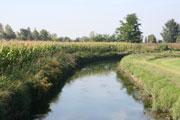
Archaeological Site
The Area of the Archaelogical Site
Fertile lands abounding with wildlife The villa in Palazzo Pignano was built at the centre of an extensive elevated region. The area is bordered to the west and east by two lower sections. The western side was likely to be flooded by water from the Adda River in the spring and autumn, while the area to the east was covered by a swamp called the "Moso", which varied considerably in depth and extent. This strip of elevated ground where the Palazzo Pignano was built is among the most fertile areas of the Po Valley, and is suitable for cultivating cereals.
The villa in Palazzo Pignano was built at the centre of an extensive elevated region. The area is bordered to the west and east by two lower sections. The western side was likely to be flooded by water from the Adda River in the spring and autumn, while the area to the east was covered by a swamp called the "Moso", which varied considerably in depth and extent. This strip of elevated ground where the Palazzo Pignano was built is among the most fertile areas of the Po Valley, and is suitable for cultivating cereals.
Towards the end of the Roman Empire, Mediolanum, or present day Milan, became the capital of the Western Empire. Therefore, Roman nobility built their important homes in the area, to resemble those they had in Rome or in other parts of the Empire in terms of luxury and comfort. Thus the Romans began settling in this area from the 3rd century B.C. but it was not until the 4th century A.D., after many changes to the organization of landed property, that the two villas at Palazzo Pignano and Rovereto di Credera were built.
The rich landowners who built the villa during the late antiquity did not choose this area by chance: the fertility of the soil was also suited to raising horses, the swampy areas close by were ideal for hunting and fishing, the presence of a navigable stretch of water and the important road link between Milan and Cremona, all made this area especially appealing.










